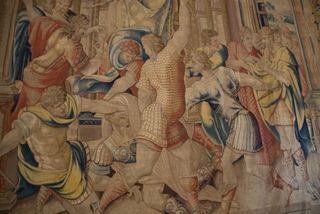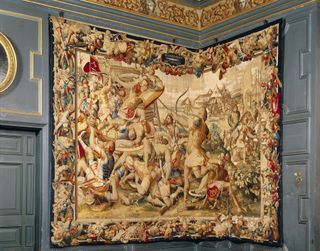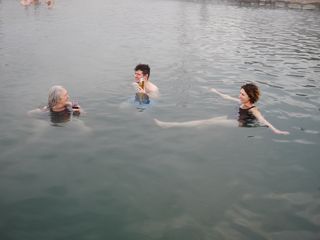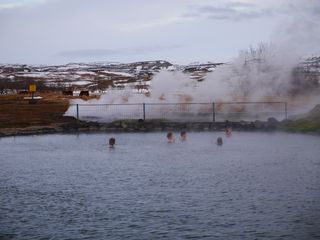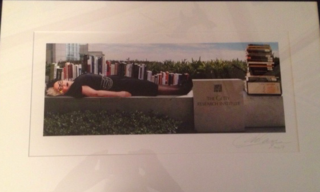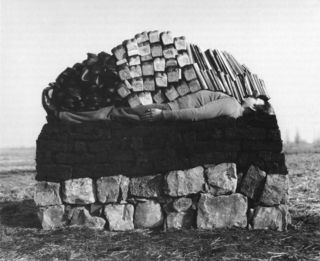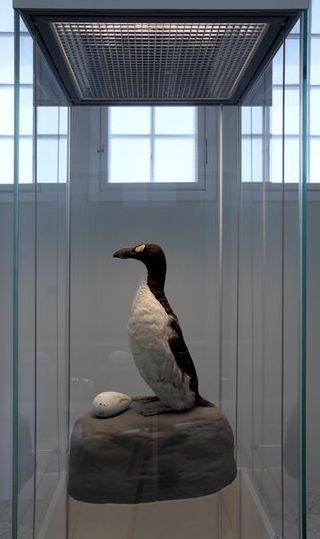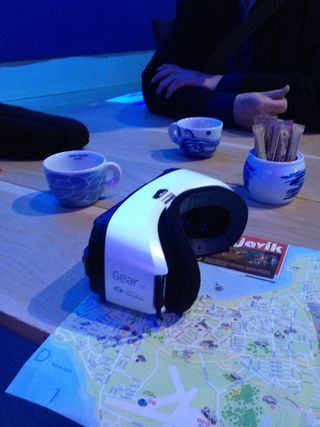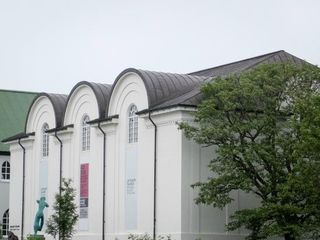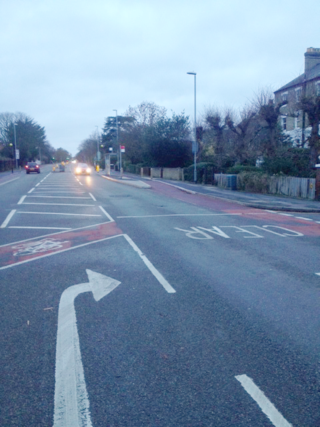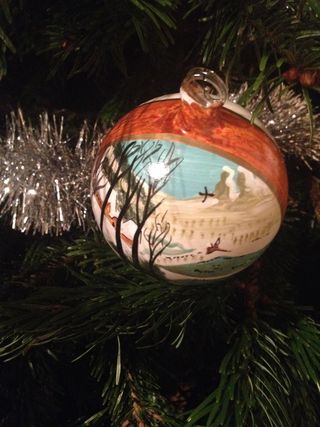Mary Beard's Blog, page 17
January 21, 2016
A tapestry convert
I used to be the kind of person who gave large Renaissance or Baroque tapestries a miss. I would spend forever looking at grimy paintings, but tapestries -- with dull figures, indistinguishably classical, biblical or more recent historical, draped over the walls of usually ill-lit corridors -- somehow never made me stop.
It is only since doing my '12 Caesars' project looking at images of emperors in Renaissance and later art that I have come to see the wonder of tapestries, to understand that the interwoven silver and gold thread, in amongst bright colours now sadly -- and differentially -- faded, on vast 'canvases', shining out against the flickering lights of the candles must have made for some of the most spectacular displays on interior decor in the Renaissace and early-modern worlds. And they were also where the money of the super-rich went. When the property of Charles I was valued after his exacution, the priciest (movable) items of all were two series of tapestries: one of the story of Abraham, the other of the story of Caesar and Pompey.
None of the Caesar and Pompey series from the royal collection still survives (it's a mystery what happened to it), but one similar piece of the same date (1540s) still survives in the Vatican: "The assassination of Caesar" (above).
This series was commissioned, or bought on spec (though that seems implausible), by Henry VIII for Hampton Court, and has been the subject of an enormous amount of detective work, by Tom Campbell, director of the Met, and others. It is a wonderfully enterprising bit of tapestry archaeology, trying to go from a whole series of later weavings, up to the mid seventeenth century, back to what Henry VIII had on his own walls.
Some of the most interesting of those later weavings have ended up in Powis Castle. They include the battle scene above, which is known in several versions. The headings in the different tapestries call it "Caesar making an attack" (as here at Powis), "Caesar fighting a giant" or (to judge from the description of a lost work) "Caesar taking the town of Gomphi". My view is that, whatever the woven captions, the original designer of the scene had a very different incident in mind, from Lucan's Pharsalia. I'll tell you what I think soon. But I just wondered if the scene looked as obvious to anyone else who knows Lucan as it does to me.
If so we could make a bit of a difference to the history of tapestry!
January 16, 2016
"The most northerly Indian restaurant in the world"
Museums apart, I guess it goes without saying that, if you're coming from the UK, the most mind-blowing -- and sometimes slightly uncomfortable -- thing about Iceland is its extraordinary environmental "otherness" (as we pretentious types might put it...I suppose I mean "the weather" and a bit more besides). When we were there, there were about four and a half hours of daylight, from about 11.00 in the morning till about half past three in the afternoon, which made a long lie in very easy, but getting down to what work we had brought with us, proved preternaturally difficult. What time most Icelanders got to work was hard to know, but the city did seem incredibly quiet until it was getting light. Maybe you just get used to it (3 days is a bit short for a fair experiment) but we were tempted to imagine that they all worked incredibly long hours in the summer when it was light for 23 hours a day and incredibly short ones in the winter.
The other thing, of course is all the geothermals, seismic activity and the cauldrons of heat stirring under the surface of the ground (the vast majority of Iceland���s power and heating comes from the energy bursting out underground). And we didn���t miss out on the tourist trail for these.
On one of our days there we left town and visited the spouting geysirs (Icelandic word) which spew steam and boiling stuff into the air every few minutes, to an admiring throng; and just a few miles away a semi frozen waterfall (above). And best of all, for me, was an outdoor pool.
I had read about the pleasures of bathing in hot pools while it gently freezes outside, but I hadn���t quite believed them ��� and certainly hadn���t thought I would indulge (and I had anyway, in a Freudian lapse, ���forgotten��� my swimming costume). But when we got to the outdoor pool of Gamla Laugin (which means ���Old Pool���), and we saw people drifting about in the hot water, gently quaffing glasses of beer and red wine, I hired some swimwear and joined in. It was, I have to say, probably the most memorable moment of the trip.
Closely followed by a great Indian meal at what is widely claimed to be the world���s most northerly Indian restaurant (in truth, I think it is beaten by one in Tromso, but that���s for another time!). We had had a three nights of nice, but not especially stunning, ���New Nordic���, and some stereotypical tourist frisson about some of the birds and animals on the menu (despite what the guide book claimed, we didn���t actually eat anywhere offering puffin burgers or guillemot and so escaped that moral dilemma). But it probably says something about the cuisine (or about us) that by the final evening we were ready for a change: Indian food with a bit of an Icelandic twist (langoustine curry, for example).
If you are in Reykjavik, then I heartily recommend the Austurindia restaurant. In fact it was the one place we ate where locals well outnumbered the tourists.
January 13, 2016
Icelandic inspiration
On a wall at home we have photograph by the French performance artist Orlan. It is a souvenir from 2007 when the husband spent a year at the Getty Research Institute in California, and Orlan was another of the resident scholars -- and this was Orlan's present to her fellow chums (in fact I think if you look close you'll see one of the husband's books lined up in the row behind Orlan herself, for that is she). It is a fun favourite of ours.
So imagine the surprise when we went into the Culture House in Reykjavik and saw this:
It's a photo by the Icelandic photographer Sigurdur Gudmundsson, done in the early 1980s, which must be where Orlan got the idea from. The stiff prostrate figure, with the books (or in Gudmundsson's case books, loaves of bread and boots) lined up behind. Now I am not meaning that Orlan ripped the idea off.
Her picture is in fact a rather wonderful riff on the earlier one -- transposing the bleak landscape of Iceland for the warm and rather cushy Getty Institute, and making it very definitely a memory of a library by leaving out the bread and the boots. Yet it certainly changes the Orlan picture for us.
And especially so, as one of the big themes of the exhibitions in the Culture House was precisely that: "again and again": "The history of art." as its guide insists, "is for the most part a history of repetition. . .". That's certainly how it was for us.
The Culture House is the Museum we left to the very end of our visit. It's bang in the very centre of the city -- and its rather elegant webguide is here. The building was put up in the early twentieth century to house the National Library and Archive, plus the Museum. And now these all have other homes, it has been recouped for a stunning show that mixes up pieces for several of the national collections under different themes ("again and again" is just one; there's also 'up' and 'down', 'inside' and outside'... ). It celebrates manuscripts next to sculpture, image next to text.. and the wonders of the natural world.
One of our favoirite exhibits, and in some way the star of the show, was a stuffed Great Auk. The last Great Auk in the world was "murdered" (that's what the label says, I seems to recall) in the mid nineteenth century in Iceland. This one was was up for sale in Sotheby's in 1971, and in a splendid fit of national conscience, the Icelanders had a massibe whip round, bought the thing (for the price of a three-room apartment, so the label again claimed) and proudly installed it back "home" (as it were).
We went away a bit impressed!
January 10, 2016
Museums in the dark
We are having a mini family break in Reykjavik. The wrong time of the year maybe, but the idea was to come north to discover what it was really like being in a very cold place with about four hours usable daylight each day. The answer is that it is as surprising as we expected. Reykjavik is small, manageable, friendly and pricey. And, if you give into the temptation to stay in bed until there is a glimmer of light, you wont be rising till close on 11 o'clock.
We have, however, been largely resisting that and spent one day over-dosing on museums.
First off was a place called Whales of iceland. A curious choice for the likes of us, but as we had no stomach for going out on a whale watching boat (few whales are apparently spotted, and anyway it is so perishingly cold that few people take up the offer of a second free day if you miss a whale on the first), we thought we would go and see some life-size models. Which is exactly what it turned out to be! But any slight disappointment was mitigated by the fact that a free cup of coffee was included in the price, and also by the fact that they were trialling some virtual reality glasses which gave you the illusion of being under water wth the sea-life.
To be honest, I didn't expect much of these (resting on the map above) especially when it became clear that they were constructed out of a smartphone attached to a pair of goggles. But actually it worked rather well, the experience of getting rather too close to digital whales underwater surprisingly believable. And it led to a long discussion as we walked away to the possibilities of these things in other museums. The daughter, who is more up to the minute on museum technology than the rest of us, claimed that you would shortly be able to explore Pompeian houses and interrogate the occupants, just by wearing a pair of specs and some head phones. (Did we like that idea.....? We rather disagreed.)
Next stop (which proved to be an hour's walk away, given the wind and another coffee stop) was the National Gallery.
It's in a splendid converted icehouse (couldnt quite work out why you needed an icehouse in Iceland..) but I would give it a miss if you are visiting soon, as half the exhibition space is shut. They gave us half price admssion, but I wasnt sure that the scuplture of Nina Saenundsson was quite worth the effort (she did the sculture o the outside of the Waldorf Astoria in New York, but what they had here really wasnt so striking). For me, the most impressive piece on show was a tin portrait of Jacqueline by Picasso, with a curiously Icelandic connection (given by Jacqueline Picasso to the Icelandic president).
The highlight though was the National Museum of Iceland, about 10 minutes walk away from the gallery. It is a splendid display of Icelandic history from the beginning right up through the first named census in the world in 1703 and full independence in 1944 -- to now. The first display was four Roman coins and a bit of Roman pottery (that does not mean the Romans got to Iceland despite some elaborate fantasies; they were presumably bits and pieces brought by some later visitor -- Viking? -- from Britain). The husband spent most of his time with the medieval things, while the son found me an image of Julius Caesar on a sixteenth-century German tankard, plus (not in my picture) Alexander the Great and Judas Maccabaeus. The truth is that a lot of the most interesting stuff was not actually made in Iceland.
I was not quite so historically austere. I fear that I stooped to trying on the Norse helmet and had fun in the twentieth-century sections. There is something 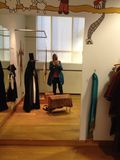 wonderfully nostalgic about peering in museum displays at things that you used to own. I spent sometime relaxing in the "late 1950s and early 1960s sitting room" and it was indeed much like the rooms in which I grew up, complete with bakelite telephone. And the first portable computer (the size of a suitcase, as the label insisted) was strikingly similar to the one I first used in the office of the Classics Faculty in Cambridge, when I went back there to a job in 1984. There was just one for us all to share and the "floppy discs" were more or less the size of an old LP. But that's another story . . .
wonderfully nostalgic about peering in museum displays at things that you used to own. I spent sometime relaxing in the "late 1950s and early 1960s sitting room" and it was indeed much like the rooms in which I grew up, complete with bakelite telephone. And the first portable computer (the size of a suitcase, as the label insisted) was strikingly similar to the one I first used in the office of the Classics Faculty in Cambridge, when I went back there to a job in 1984. There was just one for us all to share and the "floppy discs" were more or less the size of an old LP. But that's another story . . .
POST SCRIPT
Just in case Icelanders think I have missed another great museum: after writing this and before leaving town, we went to the wonderful Culture House (we'd kept it till last as it was opposite our hotel) -- which will be getting a post of its own in due course.
January 6, 2016
Online treasures
I suppose it goes without saying that the one thing that has made more difference than anything else to my working life (and I mean writing and research rather than teaching) are the online resources that have become increasingly available over the 40 years of my career. No surprise there: all Greek texts ready and waiting at the click of a button; and all those possibilities of global searching. That's not always a terribly profound activity, it must be conceded. How many times, and when, Cicero uses, say, the word dignitas may be, and sometimes is, a useful and revealing fact; sometimes it isn't. But it is still amazing just to be able to do it.
But for me it's not just the availability of resources that has made the difference...it's what that availability has done to my life-style that make the worl see changed. That is, it's made me an awful lot more sedentary. In the old days, I would be working happily at home on a Sunday, then suddenly find that I needed an article, so would hop on my bike to the deserted, chilly library to look it up. Now the chances are that I can find it on Jstor without leaving my armchair (I realise that this makes me a very privileged person... Jstor is a very expensive resource, and there are numerous institutions in the world, let alone individuals, who cannot afford it; in fact, until the world of information becomes completely open access, the great academic divide will remain between those with Jstor and the 'Jstor-less'.) Now, even when I see a reference to a book that looks as if it might be useful, I'm likely to see if I can get a glimpse on Googlebooks first, before bothering to leave the office or the house (thereby, of course, missing some of the opportunities of discovering the gems that might lie next to it of the shelf). And the truth is that if I am feeling really lazy, I will see if the book is available second-hand online for ��1.89 plus postage -- and if so,I'll order it and spare myself the journey.
Part of me then has become blas�� about what the web has to offer. But even I am sometimes amazed by the resources freely available, and the labours of love that must underlie them. And here are three.
First, the Metropolitan Museum in New York. It was the husband that pointed out to me, as I was buying a sumptuous Met exhibition catalogue, that almost all that were available, including full text and images, are also online for free. Click the link (as it isnt quite obvious where to find the stuff, but once you do it's all there).
Second, the New York Public Library has a vast collection of images, available without fee for ordinary usage, and with only a modest fee for reproduction rights. It's a really amazing (and cheap) archive.
Third is Pers��e, which is more or less the French equivalent of Jstor and gives access to loads of French academic articles and more ... and is free to use and download unlike Jstor.
Just occasionally it is hard not to be humbled by the efforts it took to get all this stuff onlne, amd potentially make it available to all
January 2, 2016
Bikes, bus stops and pedestrians
When I reported on my conference- and museum-visit to Vienna a few weeks ago, I spared you my little moans about the terrifying system of cycleways that criss-cross the city -- terrifying for unfamiliar pedestrians, that is. I assume that the locals have internalised the different significance of the red and green tracks, because despite the speed of the passing bikes I didnt actually see any ordinary walkers mown down. But for the averagely observant stranger the whole pavement network fely close to a death trap. The picture above is a case in point, where you will see the pedestrian symbol caught between bikes going in different directions. In other places you would be dutifully following the 'walking person' sign, only to discover that it changed apparently without warning into a superfast bike highway.
Now, as an habitual cyclist, I am in principle dead keen on bike lanes. But the problem of turning roads never designed for the purpose, at least not at the present volume of traffic, into convenient and safe spaces for cars, bikes and walkers is never quite as simple as it seems -- as I've just discovered in my own street, where the local council has just installed a 'wide-enough-for-two-bikes' cycle lane down one side of the road.
At first sight, there is much to applaud here -- even though this is not at the top of the list of the most dangerous roads in Cambridge (which you can see in an appendix to this document , it is only on one side of the road and the lovely new cycle lane actually comes to an abrupt halt just where the going gets really rough for those on two wheels. You might now be able to bike in this far from Girton side by side on a slightly raised surface, but soon you will be faced with a much less desirable single track, which -- 500 metres down the road at one of the nastiest junctions in town -- is simply interrupted for about 10 metres, so that cars can cross from one side of it to the next, before blithely picking up again on the other side. What the hell cyclists are supposed to do at this point,I haven't a clue.
All the same, some improvement might be better than nothing you might say. But there are some uncomfortable unintended consequences of the new scheme, which includes a system of 'floating bus stops', where the bus stop is on an island and the cycleway runs between the island and the pavement (as in the picture above). What this means is that cyclists do not get held up behind buses stopping to pick up passengers. What it also means, as I hope you'll be able to see from my rather murky photo, is that cars trying to turn right now not only have to watch out for two lines of oncoming traffic at different speeds (bike and cars), but worse the cyclists are actually partly concealed by the bus shelter from drivers waiting to make the turn by the arrow -- and that hardly makes it safer for anyone.
The other problem is pedestrian access to and from the bus stop. You now have to cross the cycle path to get to the stop, and the cycles are coming down the road at quite a lick -- and, as again I think you can see in the picture, they are not very forciby warned of the likelihood of pedestrians crossing. There is a warning, but I am not sure if it is enough to stop some slightly slow, elderly passenger getting mown down before too long. The defence is, I believe, that very soon, just like the good burghers of Vienna, we will get to internalise the new arrangements which then won't be dangerous at all and will have created better conditions for cyclists. I hope so, but I am not 100% confident.
To return to the theme of another recent post, this is not "Prof raps cycle lanes". The Prof's usual method of transport is on two wheels, thank you very much, and there is nothing she woud like more than safer cycling. She is also sure that the people working in the local council want that too. But she cant help thinking that we need some more imaginative or radical thinking than simply trying to squash new lanes that won't quite fit into highways never intended for them. One of the next proposals for a neighbouring road involves cutting down the nice trees that give it its character . . . hang on a minute....
December 30, 2015
Putting a book out into the world
In the old days, that is about fifteen years ago, when you published a book it was hard to know what anyone really thought about it, or even what happened to it once you had signed it off. If you had written a book for a wide audience, you might expect a few reviews in the mags and broadsheets; if it was strictly academic, you might wait two or three years before you saw a review or two in the journals (but by that time you had forgotten what was driving you in the book and were well into the next project). Meanwhile your colleagues would have been generally nice about what you had written (they weren't really likely to assault you over the photocopier with an attack on your reading of Cicero's De Officiis), and you would have had a couple of letters from readers who had either loved or hated what you had written.
It is happily different now. I already shared with blog readers the process of writing my SPQR and got huge amounts of straight constructive criticism and helpful support online (on everything from the title to the structure of Chapter 9 -- or was it 8 -- that bogged me down for weeks). But I hadnt quite realised how that now went on after the book was published. OK this may sound naff, but I have had such fun getting tweets over Christmas from people who were actually starting to read SPQR, with wonderful pics of it among the Xmas presents, with the family dog and so on.
Quite a lot of the comments were upbeat, happy and complimentary, but there were also some welcome queries and criticisms which I answered as best I could in 140 characters.
Beyond that, of course, you get longer reviews on Amazon.co.uk and Amazon.com. Now, I have been very lucky in getting some great reviews in the prints for SPQR, and have been extremely grateful for them (for criticisms as well as praise). But it is also wonderful to read, as you couldn't access before, the comments of those who simply chose to read it. To put it bluntly, what did those who were not paid (albeit only a little -- reviewing is not a lucrative business) to think and comment, think about what they had actually paid to read?
Obviously it is nice to have the pats on the back (I am very grateful to them -- thanks all); but it is also good to read the criticisms of those who have read the book carefully and disagreed (even the discussion of whether you should use BC/AD or BCE/CE is not unworthwhile). Unsurprisingly though there is still a bit of the usual 'below the line' stuff. That partly offers an uncomfortable insight into how some people (wilfully) process what you write. I couldn't work out why I was accused of attacking the "State of Israel", until I realised that it was some strange version of my observation that Cicero's words against Catiline (Quousque tandem..?) had recently been used against any number of modern targets, including the State of Israel (I also named the President of Syria as another target); and I still haven't worked out where I have brought in the Vietnam War (though maybe I did..?). And one guy decided that the only reason that there were any five star reviews of the book at all was because they were not entirely 'independent' (an insult to my intelligence as much as to my moral probity -- you would have to be mad to do, as is reported, 'an Orlando Figes').
But in the midst of some predictable jibes -- about how "Cambridge ought to do better than this" or "Afraid Mary is more of a frustrated political activist with a soft nest of tenure at a long established English university that allows her to cast not so subtle political opinions into a purported "history"" -- there was some even more predictably gendered stuff. When I (OK, a bit obsessively) looked at the reviews on Amazon.com yesterday, I saw a comment which said that I should go to the hairdresser. You've got to laugh, I thought... in a BOOK review!
When I went back today that particular review seemed to have diappeared. I guess the good news is that even the angry poster thought better of it. Thank you, whoever you are, all is forgiven.
December 25, 2015
Happy Christmas
I discovered from an unusually full diet of the Sunday papers last weekend that one of the Duchess of Cambridge's distinctive extravagances was have TWO Christmas trees. Now Anmer Hall is considerably more capacious than my home in NW Cambridge, but I have to confess that I also have TWO trees... no doubt not as grand as Kate's, but necessary for displaying the increasing quantity of upmarket tat, collected over the years, that brightens the end of December. (Picture above of the daughter in action, who did the lion's share of the decorating this time.)
Each year we acquire a few extras baubles which add to the array. Pride of place for obvious reasons goes to a Roman 'SPQR' (acquired from the Vatican Museums shop on Fiumicino airport):
But that is joined by a splendid bit of Bruegel, from Vienna, with winter scene:
And, of course, they are also joined by some of the old favourites. There's a bit of gaudy memorabilia from Princeton University:
And there are some decidedly disreputable historical characters too, who may well get banned from Christmas tree appearances within my lifetime:
But by the time you read this ... we willprobably have done our presents (11.00 sharpish) and be immersed in the cooking not the tree.
There is no truck in this house with such heritage items as goose or beef. We have a good old twentieth-century style turkey, with stuffings, chipolatas and brussel sprouts, followed by Beard's Christmas Pud and brandy butter. And it is all consumed after we have watched the Queen's Speech at 3.00 and done a bit of drunken analysis of its politics. I am usually the one to find some subversive reading in what Her Majesty has to say, unconvincingly to most of the rest of the family. A bit of time is usually happily spent too comparing the royal Christmas tree to our own (though this cgame has been rather undermined by the discovery in the papers last Sunday that most of the baubles are actually BBC props, as well as a good number of the cards scattered around the place...were we always naive to think otherwise?).
Then I expect that it will be the Downton Abbey Christmas special and finale. I haven't watched it for many a series, but I doubt that will make much difference. and with no book to write (an activity which rather dominated last Christmas) perhaps I will get to read one -- for fun.
So Happy Christmas all.
December 23, 2015
The life-cycle of a blog
The point about a blog, as I see it, is that it is a bulletin about thoughts and works in progress. It is not ill-considered but it is 'occasional' in the strict sense of the word, reacting to events as they happen, a 'reporting in'. Hence the idea that they can be done late at night, as you might do a diary.
It is then very strange when a blog becomes an article in a print newspaper, especially -- as has happened in the last few days -- under headlines, referring to my last post, such as 'Mary Beard raps zealots in Oxford Rhodes row', going on to say 'Classicist and TV historian Mary Beard has railed against zealots at Oxford University who want to tear down two memorials to Cecil Rhodes but ���go on using his cash���'. Now to be fair to the Daily Mail, and other papers, this was in the public domain anyway (and sometimes I am very pleased to have my blog story taken up more widely, as in the case of Norfolk archaeology); and to be fair again to the Mail, they did make it clear that my comments came from a blog not an interview (that distinction gets blurred more often than not).
All the same, somehow the whole genre and the nuance of reflective immediacy (or, to put it another way, temporary sounding off) of the original is lost under what begins to look like a consistent campaign, whether the headline is 'Mary Beard raps zealots..' or 'Rhodes scholar branded hypocrite for leading campaign to have Rhodes' statue removed criticised by Mary Beard'. Beard never actually 'rapped' anyone!
And, of course, the fact that I think (and said) that the academy has a case to answer on racism, and that I rather admire the feistiness of some of the protagonists such Ntokozo Qwabe, doesn't get much of a look in. My objection is to the removal of the statue, and to the idea that it helps anyone to efface the flawed ancestors whose money (which allows us to do many things we value) was -- to put it at its mildest -- 'tainted'. I want us to face the nasty side of our history, not to take it away from public view, and I want to empower those exploited to walk past the statues of Rhodes and others with a sense of (as I put it) 'unbatterability'.
But that is where social media and Twitter kick in to the story.
Again, I dont blame the tweeters; they are reacting to the newspaper reports which are some way from what I actually wrote, or at least selective quotations from it. But as soon as a little Twitter storm erupts, the limitations of the medium and its 140 characters, for good discussion becomes glaringly apparent. One person is soon saying that I am 'out of my depth', a current synonym for 'I dont agree with you', with added moral superiority (there is no in or out of depth on this issue -- any responsible citizen should be thinking or speaking about Rhodes and racism). Another is attacking me for citing in my blog only two white males (they happened to have been the articles I read in the papers that day), and goes on to imply without actually saying that I, white Cambridge woman classicist, have never talked about this issue with any people of colour (wrong, but I dont see why I should name my black friends, as a category). Another accuses me of disparaging Ntokozo Qwabe (which a quick check on Twitter would easily have shown was not the case, even though the 'criticism' gets picked up and repeated in Cherwell). And the language of non-negotiable obligation is everywhere. 'But you must understand that given the current situation, the preservation of Rhodes statue is deeply traumatic?' (my italics). And so is the language of false analogy: 'would you say the same about a statue of a notorious serial rapist of white women?'.
As I said, none of these committed people are much to blame. They have simply taken selective reports at face value. They have fallen victim to the crudifying power of 140 characters. And perhaps they have forgotten that people can share ends, but disagree about the means. There are many of us who think there is a big job to do in countering racism in the academy (as much as everywhere else), but who fundamentally reject the removal of the statue -- and our reasons are not conservative racism. The fact that I disagree with that aspect of Rhodes Must Fall does not mean that I am 'out of my depth'.
Don't think of this as too much of a complaint. Noone has done worse (me included, no doubt) than be a bit sloppy. But it is a microcosm of the chinese whispers that so easily becomes our 'news'.
December 20, 2015
Cecil Rhodes and Oriel College, Oxford
There has been a good deal of sound and fury over the last few days about Oriel College's plans to remove the plaque in honour of Cecil Rhodes on one of their college houses, and to take down his statue from the facade of their "Rhodes building" -- the reason being that his racist views are incompatible with a modern university. As I understand it, they are waiting for local government consent to remove the plaque (which is in a conservation area) and are having a six month thinking period about the statue.
Among all the huffing and puffing, Will Hutton -- as often -- had some sensible things to say in the Observer, and he was careful to point out that (whatever you think about the statue) there was an important campaign going on here about the politics of southern Africa, and the politics of the history curriculum both in Oxford and Capetown. (Whether the opposition to those statues both in the UK and UCT will prove to be a good headline grabbing piece of PR or a miserable distraction remains to be seen.)
But Hutton was with most of the comments I read -- stressing that the campaign to eradicate Rhodes from our consciousness was in many ways a foolish enterprise, which probably did more harm to our understanding of history (and capacity to argue with it and take a different stance) than the campaigners will admit.
For a start, as Hutton suggested, the idea that Rhodes was a particularly dreadful lone racist wolf in the late nineteenth century is completely barking. The chances are that almost every one of the Victorian worthies who decorate our streets and cities held views as bad or worse. And a great statue cull, based on twenty first-century values, would leave few in place.Would Boudicca the sadistic terrorist (or alternatively founder of our island's imperial ambitions -- as the inscription underneath her suggests) survive on the Embankment? I doubt it.
But, you might say, she was a figure from as far back as the first century AD. But, to be honest, I'm not sure that age or longevity is the deciding factor here. Or, at least, where is the logic in suggesting that an ancient or a Renaissance racist might be left with his or her statue, but a late nineteenth century one not?
Much more imporant is to look history in the eye and reflect on our awkward relationship to it, and what we are actually beneficiaries of, not simply to photoshop the nasty bits out. I couldn't help thinking about David Mitchell's reflections a week ago about the removal of Donald Trump's honorary degree:
"I dislike," he wrote, "the trend for ���stripping��� the disgraced of the honours bestowed on them when they were in our good books. I think if it turns out you���ve made, say, Hitler an honorary PhD in peace studies, the record ought to stand as a rebuke to your whole honorary doctorate admissions policy. Otherwise it���s like a denial of historical fact: the truth is that, in 2010, Robert Gordon University thought Donald Trump was the bee���s knees and they shouldn���t get to erase that from their annals now it turns out he���s a prick."
Rhodes may be a good deal worse than a "prick", but basically the same goes. We get nowhere if we try to conceal the past was aggressively not like us. To put it the other way round, if you go to Turkey now, you will find that the act of smoking in every old movie has by law been pixellated out (makes a bit of a mockery of Casablanca)... but hang on peoplre in the past SMOKED, you know.
Of course, I have some sympathy with the idea that an ethnic minority student in Oxford (the Capetown position may be different in many ways) could find it a bit in your face to have an image of Rhodes or any run of the mill Victorian racist staring down on them. But the battle isnt won by taking the statue away and pretending those people didnt exist. It's won by empowering those students to look up at Rhodes and friends with a cheery and self confident sense of unbatterability -- much as I find myself looking up at the statues of all those hundreds of men in history who would vehemently have objected to women having the vote, let alone the kind of job I have.
And then there's the money. I really dont think that you can have your cake and eat it here: I mean you can't whitewash Rhodes out of history, but go on using his cash. And his cash has done a huge amount of good in bringing foreign students to this country (take a look at those elected to Rhodes scholarships for next year). Wouldn't it be better to celebrate what we have managed to achieve with Rhodes's money, whatever his views. If he was bad, then we have certainly turned his cash to the better... and maybe, to give him for a moment the benefit of the doubt, if he had been born a hundred years later even he would have thought differently.
Clich�� of the evening: it's not the job of the present to tick the past off, but to get off its backside and do better!
Mary Beard's Blog
- Mary Beard's profile
- 4110 followers


